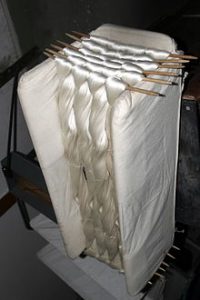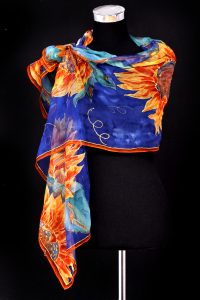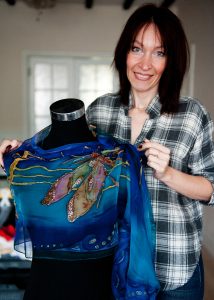Silk
Background
Silk has set the standard in luxury fabrics for several millennia. The origins of silk date back to Ancient China. Legend has it that a Chinese princess was sipping tea in her garden when a cocoon fell into her cup, and the hot tea loosened the long strand of silk. Ancient literature, however, attributes the popularization of silk to the Chinese Empress Si-Ling, to around 2600 b.c. Called the Goddess of the Silkworm, Si-Ling apparently raised silkworms and designed a loom for making silk fabrics.
The Chinese used silk fabrics for arts and decorations as well as for clothing. Silk became an integral part of the Chinese economy and an important means of exchange for trading with neighbouring countries. Caravans traded the prized silk fabrics along the famed Silk Road into the Near East. By the fourth century b.c., Alexander the Great is said to have introduced silk to Europe. The popularity of silk was influenced by Christian prelates who donned the rich fabrics and adorned their altars with them. Gradually the nobility began to have their own clothing fashioned from silk fabrics as well.
 Exhibit Introduction. Silk Road Map
Exhibit Introduction. Silk Road Map
Initially, the Chinese were highly protective of their secret to making silk. Indeed, the reigning powers decreed death by torture to anyone who divulged the secret of the silk-worm. Eventually, the mystery of the silk-making process was smuggled into neighbouring regions, reaching Japan about a.d. 300 and India around a.d. 400. By the eighth century, Spain began producing silk, and 400 years later Italy became quite successful at making silk, with several towns giving their names to particular types of silk.
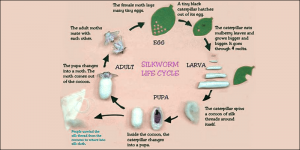 Silk obtained from silkworm: Silkworm lifecycle.
Silk obtained from silkworm: Silkworm lifecycle.
Raw silk of domesticated silk worms, showing its natural shine
The first country to apply scientific techniques to raising silkworms was Japan, which produces some of the world’s finest silk fabrics. Other countries that also produce quality silks are China, Italy, India, Spain, and France. China was the largest exporter of raw silk in the early 1990s, accounting for about 85% of the world’s raw silk, worth about $800 million. Exports of China’s finished silk products were about half of the world’s total at about $3 billion.
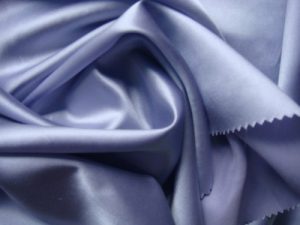 Introduction The silk satin is a tightly-woven high quality fabric. The sheen looks quite noble, and the touch is smooth and elastic.
Introduction The silk satin is a tightly-woven high quality fabric. The sheen looks quite noble, and the touch is smooth and elastic.
Silk is highly valued because it possesses many excellent properties. Not only does it look lustrous and feel luxurious, but it is also lightweight, resilient, and extremely strong—one filament of silk is stronger then a comparable filament of steel! Although fabric manufacturers have created less costly alternatives to silk, such as nylon and polyester, silk is still in a class by itself.
Care of Silk Fabric: General Precautions
- Silk is a natural protein fiber. Do not use chlorine bleach to clean silk; chlorine will damage the silk fabric
- Avoid drying silk in direct sunlight as sunlight for a prolonged period will damage the silk fabric
- Substances containing alcohol will damage silk fabric. So let your perfume and hairspray dry before dressing
Hand Washing Silk
- Hand washing silk is our recommended mode of cleaning silk. Almost all silk can be hand washed (and would not shrink if the silk fabric were pre-shrunk before sewing)
- If you have hard water, you may wish to first add a spoonful of borax to the washing water
- Use lukewarm water and mild, non-alkaline soap (such as Ivory Liquid) or baby shampoo
- While rinsing, you can add a few tablespoonfuls of distilled white vinegar to the rinse water to neutralize alkali traces and to dissolve soap residue
Or, add a few drops of hair conditioner to the final rinse water for extra silky feel - Soaking silk for any more than a few minutes should be avoided
- Do not use harsh detergents that contain bleaches or brighteners
- Do not wring or twist; roll in towel to extract water
Silk Care: Drying Tips
- Hang silk garments to dry. The silk garment will hold its shape
- As with any fine fabric, never use direct sunlight to dry silk clothing. Doing so can damage the silk fiber and fade the color. Wet silk may yellow in direct sunlight or on a radiator
- Don’t use a wooden drying rack, as the dyes & finishes can leave stains
- We do not recommend drying silk in a clothes dryer since it can damage silk in two ways: (1) excessive temperature and heat dulls the silk fabric and may also shrink it (2) friction with the dryer drum might cause yarn breaks or white streaks
- If you do wish to use a dryer, use the heatless AIR FLUFF setting
Silk Care: Ironing Silk
- If necessary, press the silk garment inside out while damp using cool iron setting (“Silk” setting on the iron)
- Do not wet locally as this may cause rings
- Too much heat can dull, pucker, or burn silk fabric
- Most wrinkles in silk can be removed by hanging the garment in the bathroom during a shower. Let humidity do the ironing for you!
Cleaning Silk: Wrinkle Removal Tips
- Minor silk wrinkles should disappear if the garment is hung overnight
- Stubborn wrinkles can be removed with a cool iron set on “silk”
- Better yet, hang your silk garment in the bathroom during a shower. Humidity will remove the wrinkles for you
Cleaning Silk: Silk Stain Removal
- Please consult with your dry cleaner
- As with all fine fabrics, NEVER use chlorine bleach on silk, as it will erode the fiber (not to mention the fabric discoloration)
